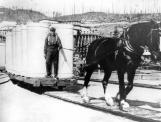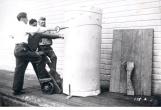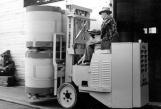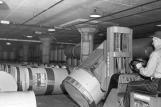1
Two men carrying rolls of paper outside the warehouse at the Powell River mill. The rolls would weigh in excess of 300 pounds each.3
In the early days of our townsite, from 1911 to 1920, the Powell River Company maintained a fleet of twenty horses, quartered in the old barn on the golf course. But recently this venerable structure was removed to make way for the drives and approaches of unfeeling golfers. Three horses were used at the wharf and paper storage; one team delivered the groceries about the townsite, whose southern limits were bounded by the present site of the Gopher Club; three or four teams hauled lumber and other supplies for carpenters, plumbers, etc. One stout equine pulled the old dump cart used for the garbage route; and one horse was maintained then, as now, in the lumber yard.Powell River Digester
Vol 8 Number 12
December 1929
5
The old horse, once the backbone of our transportation system, has almost disappeared; squeezed out of service by the inexorable march of the iron-horse and fast speeding motor vehicle. Fifteen years ago, in Powell River, motor vehicles were unknown; old Dobbin, still in the full meridian of his glory ruled the transportation roost, delivered our groceries, emptied our garbage cans, hauled our paper cars, carried our lumber and supplies, and nobly enacted all those roles now played by the usurping truck and his kindred, the touring car.Powell River Digester
Vol 8 Number 12
December 1929
7
There have been several lost time and near miss accidents sustained by Paper Shipping employees, in the handling of large rolls on two-wheeled trucks, in the near past. The hand trucking of heavy materials calls for the exercise of great care from the moment of receiving the load until its delivery.Powell River Digester
Vol 4 No. 11
November 1925
9
Industrial mechanization, stimulated by war experimentation and operations, is spreading rapidly across the nation. As the modern mobile army moves on wheels, so will Canadian industry move under the impulse of many new, intricate and wondrous mechanical gadgets. Industry, like war, will be streamlined. The "bull" work is being done by machines instead of men; and much of the toil and drudgery of labor is disappearing. The old-fashioned and clumsy crane and sling are yielding place to the fast, mobile lift truck or jeep that can "turn on a dime".In Powell River mechanization has leaped forward in recent years. Jeeps and lift trucks load paper, transport blocks to the grinders, and perform scores of additional duties of our mechanical and operating staff.
Powell River Digester
Vol 21 No. 7
July, 1945
11
Today in Powell River we are entering a new phase of material handling with the introduction of clamp trucks to replace our former system of palletized loading.For the past year, the Industrial Engineering Department has been engaged in an intensive study on material handling, with particular emphasis on conversion to clamp trucks.
At the present time our rolls as they leave the Finishing Room are upended on a tilt table, placed on a pallet board and loaded onto railway cars for transportation to wharf storage sheds. Shipments out via covered barge and Puget Sound Freight Lines are shipped on these same pallets to Vancouver and Puget Sound area. In Californian and deep sea shipments, the pallet boards are left at our Powell River docks. In both cases the pallets are eventually returned to the Finishing Room to start another cycle--as a tray on which lift trucks can handle paper rolls.
Elimination of pallets would save manpower, storage space and costly maintenance bills for pallet repair.
With this in mind we started to study the possibilities of converting to double clamp trucks which would carry two rolls on a single lift. Competitive designs, including suggested improvements based on practical operating experience in our plant, were asked for. The trucks, built to these specifications, were put through the most rigid and exacting tests. We stacked, unstacked, loaded railway cars, checked speeds, accelerations, stability, driver visibility, accessibility for maintenance, etc.
As a result we have come up with a special clamp designed for a special job by the men who know attachments best; and we believe it will do a first class job--and eliminate most of the handling procedure.
The use of clamp trucks brings us in line with discharge and paper roll transportation at our discharge ports in the United States. Clamps are used in many of the modern publishers' warehouses and on the docks in many ports. At Powell River they will definitely expedite California and deep sea ship loading.
Powell River Digester,
Vol. 31 Number 1
January-February, 1955
12
Destined for San Francisco1945
Powell River, British Columbia, Canada
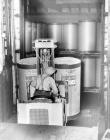 Credits:
Credits:P01196
Powell River Studio


